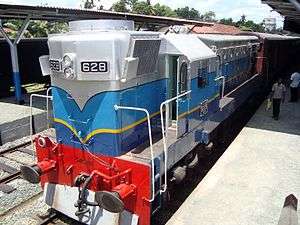CGR class H1
The CGR class H1 was a steam locomotive of the Garratt type built by Beyer, Peacock and Company for the Ceylon Government Railways (CGR), now Sri Lanka Railways. Only one locomotive was built and its CGR number was 293.[1]
| Ceylon Government Railways Class H1 | |||||||||||||||||||||||||||||||||||||||
|---|---|---|---|---|---|---|---|---|---|---|---|---|---|---|---|---|---|---|---|---|---|---|---|---|---|---|---|---|---|---|---|---|---|---|---|---|---|---|---|
| |||||||||||||||||||||||||||||||||||||||
| |||||||||||||||||||||||||||||||||||||||
| |||||||||||||||||||||||||||||||||||||||
| |||||||||||||||||||||||||||||||||||||||
Description
This steam locomotive entered to the service with CGR in 1931. This locomotive was used for working passenger and freight services in Udupussallawa railway. This locomotive met with a serious accident near Nuwara Eliya when it was hauling a freight train at excessive speed in 1942 and was silent for some years. In 1944 this was repaired and this was seen again in service. Up to 1960s, this locomotive was occasionally operated on Kelani Valley Line. In 1972 this was withdrawn from its service and was scrapped in 1981.[2]
gollark: I don't think mr wilde will mind if we come up with a better way to organize stuff and explain why.
gollark: What?
gollark: Good news! It turns out that the MPU6050 *does* have drivers which are compatible with the DMP thing and will actually run on the Pi! Unfortunately they are poorly documented C++!
gollark: Also, the robot is mostly disassembled, so it cannot* really be tested in person.
gollark: I have good news regarding the thing, also. The random accelerometer/gyroscope module which seems to be around seems pretty good and should allow rotation™.
This article is issued from Wikipedia. The text is licensed under Creative Commons - Attribution - Sharealike. Additional terms may apply for the media files.
